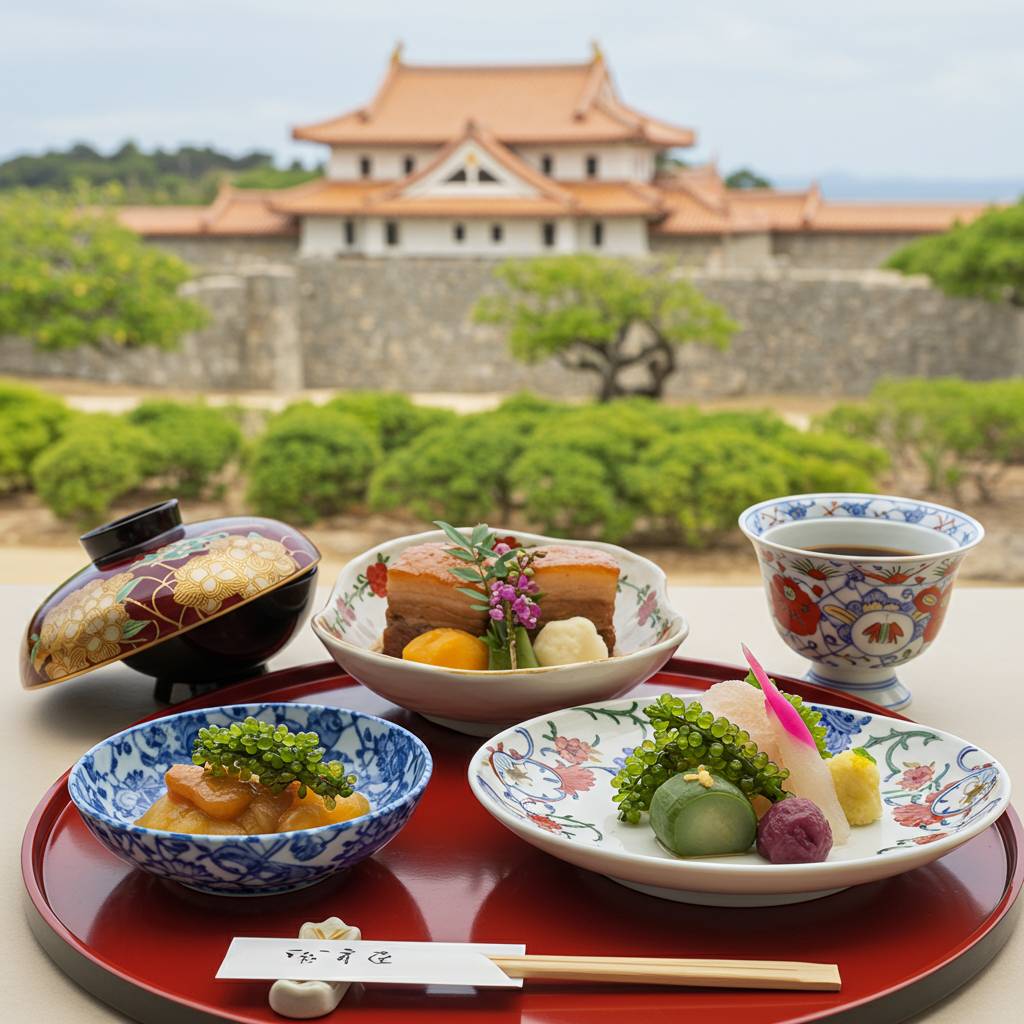# Ryukyu Cuisine: How Okinawa’s Royal Food Culture Survives Today
The azure waters surrounding Okinawa hide more than just coral reefs and tropical fish—they conceal centuries of culinary history that once graced the tables of kings. Ryukyu cuisine, born in the courts of the Ryukyu Kingdom (1429-1879), represents one of Japan’s most distinctive yet underappreciated food traditions. This royal culinary heritage continues to influence modern Okinawan cooking, offering insights into a culture that balanced Chinese influence, Japanese governance, and its own indigenous traditions.
## The Royal Roots of Ryukyu Cuisine
Long before Okinawa became Japan’s southernmost prefecture, it was the heart of the independent Ryukyu Kingdom—a maritime nation that facilitated trade between Japan, China, Southeast Asia, and beyond. This privileged position allowed the royal court to develop a sophisticated cuisine that combined techniques and ingredients from across Asia.
Court cuisine, known as “Tundabun,” was meticulously prepared for royal banquets and diplomatic ceremonies. These elaborate meals featured precisely arranged dishes presented on exquisite lacquerware, showing clear Chinese influence while maintaining distinct Ryukyuan characteristics.
## Key Elements That Define Royal Ryukyu Cuisine
Distinctive Ingredients
Ryukyu royal cuisine prominently features:
– **Pork**: Unlike mainland Japan, which historically limited meat consumption, the Ryukyu Kingdom embraced pork, particularly in the famous “Rafute” (simmered pork belly).
– **Tropical Fruits**: Dragonfruit, passion fruit, and mango appeared in royal desserts long before becoming trendy elsewhere.
– **Awamori**: This indigenous distilled rice spirit, stronger than sake, was used both for drinking and cooking.
– **Konbu**: Seaweed imported from Hokkaido became a status symbol, used creatively in dishes that showcased the kingdom’s trading prowess.
Preservation Techniques
Living on an island archipelago required ingenious preservation methods:
– **Salt Curing**: Techniques for preserving fish and other proteins were highly developed.
– **Fermentation**: Long before probiotics became a health trend, Okinawan royalty enjoyed fermented foods like “furu-karashi” (fermented mustard greens).
## How Royal Cuisine Survived Japan’s Assimilation
When the Ryukyu Kingdom was officially annexed by Japan in 1879, many aristocratic families lost their wealth and status. This could have spelled the end for royal cuisine, but several factors ensured its continuation:
– Former royal chefs found employment in restaurants and wealthy households
– Recipes were preserved through family traditions
– Ceremonial events continued to require traditional dishes
– Pride in cultural heritage remained strong despite political change
## Where to Experience Authentic Ryukyu Royal Cuisine Today
Several establishments in Okinawa specialize in preserving and presenting authentic royal cuisine:
**Kanro Suisen** in Naha recreates traditional royal banquets in a restored historic building. Their chefs follow centuries-old recipes, with each course presented on hand-painted lacquerware reminiscent of what royalty once used.
**Ryukyu Cuisine Mie** in Shuri offers a more accessible introduction to royal cuisine, with set menus that showcase signature dishes like “Jimami Tofu” (peanut tofu) and “Kubuirichi” (kombu seaweed with pork).
## Modern Interpretations
Contemporary Okinawan chefs are finding ways to preserve the essence of royal cuisine while adapting to modern tastes:
– Chef Masashi Kinjo at **Ryukyu Cuisine Kinjo** combines traditional techniques with contemporary plating
– Food researchers are documenting and recreating recipes from ancient texts
– Cooking schools now offer classes specifically in royal Ryukyuan cuisine
## The Wellness Connection
Perhaps the most fascinating aspect of Ryukyu cuisine is its connection to longevity. Okinawa has long been known as one of the world’s “Blue Zones” where people live exceptionally long, healthy lives. While everyday Okinawan food differs somewhat from royal cuisine, they share fundamental principles:
– Diverse vegetable consumption
– Moderate protein intake
– Abundant sea vegetables
– Mindful eating practices
Modern nutritionists have begun studying these traditional dietary patterns for insights into healthy aging, bringing renewed attention to Ryukyuan food culture.
## Preserving a Legacy
The survival of Ryukyu royal cuisine represents more than just gastronomic continuity—it symbolizes cultural resilience. Through colonization, war, and rapid modernization, Okinawans have maintained this culinary tradition as a living connection to their sovereign past.
For visitors to Okinawa, experiencing these royal flavors offers a taste of history more vivid than any museum exhibit. For locals, it provides a tangible link to an independent heritage that predates their Japanese identity.
As global interest in regional cuisines grows, Ryukyu royal cuisine stands poised for wider recognition—a sophisticated culinary tradition that tells the story of an island kingdom that once commanded respect throughout East Asia, and whose flavors continue to captivate those fortunate enough to experience them today.
沖縄のレンタカー予約は「レンタカー広場」
レンタカー広場で最高の旅の思い出を!
レンタカーの予約はこちらから↓
・沖縄の格安レンタカーが最安値「1,500円~」予約・比較はレンタカー広場がおすすめ
https://rentacar-hiroba.com/

